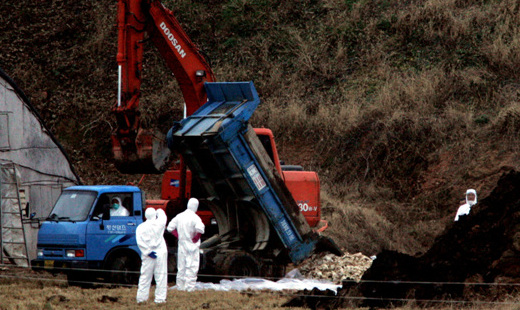SKorea reports second bird flu outbreak this week in poultry; not H5N1 strain
11.24.2006, 12:22 AM
SEOUL (XFN-ASIA) - The agriculture ministry said a second apparent bird flu outbreak this week has emerged south of Seoul, althogh the case does not appear to involve the H5N1 strain of the virus.
The ministry said some 200 chickens died at a farm in Pyeongtaek, 70 kilometers south of the capital, of a strain not considered lethal to humans.
The ministry said the government would ban the movement of birds from the Pyeongtaek farm, but added no cull is necessary.
Yesterday the ministry announced a suspected outbreak in the southern city of Iksan, the first suspected bird flu case since South Korea declared itself free of the disease last December.
Some 6,000 chicken died in three days at the farm at Seokmae village in Iksan, 250 kilometers south of Seoul, prompting the agriculture ministry to order the culling of the remaining 6,000 birds in the farm.
afp
South Korea says low-grade bird flu kills 200 chickens south of Seoul
SEOUL, South Korea (AP) - A low-grade strain of bird flu has killed 200 chickens south of the South Korean capital, the agriculture ministry said Friday.
The ministry identified the strain of bird flu as "low pathogenic'' and said that it was neither the H5N1, which can be lethal to humans, nor the less dangerous H5N2 strains.
The ministry said it would take preventive measures, including disinfecting the remaining 19,000 chickens at a chicken farm in Pyeongtaek city, about 65 kilometers (40 miles) south of Seoul. (Edt: no culling..)
The exact cause of the outbreak has yet to be determined but "it has nothing to do with a suspected case of bird flu'' in the southwestern province of Jeolla, said Lee Joo-won, an official at the ministry.
11.24.2006, 12:22 AM
SEOUL (XFN-ASIA) - The agriculture ministry said a second apparent bird flu outbreak this week has emerged south of Seoul, althogh the case does not appear to involve the H5N1 strain of the virus.
The ministry said some 200 chickens died at a farm in Pyeongtaek, 70 kilometers south of the capital, of a strain not considered lethal to humans.
The ministry said the government would ban the movement of birds from the Pyeongtaek farm, but added no cull is necessary.
Yesterday the ministry announced a suspected outbreak in the southern city of Iksan, the first suspected bird flu case since South Korea declared itself free of the disease last December.
Some 6,000 chicken died in three days at the farm at Seokmae village in Iksan, 250 kilometers south of Seoul, prompting the agriculture ministry to order the culling of the remaining 6,000 birds in the farm.
afp
South Korea says low-grade bird flu kills 200 chickens south of Seoul
SEOUL, South Korea (AP) - A low-grade strain of bird flu has killed 200 chickens south of the South Korean capital, the agriculture ministry said Friday.
The ministry identified the strain of bird flu as "low pathogenic'' and said that it was neither the H5N1, which can be lethal to humans, nor the less dangerous H5N2 strains.
The ministry said it would take preventive measures, including disinfecting the remaining 19,000 chickens at a chicken farm in Pyeongtaek city, about 65 kilometers (40 miles) south of Seoul. (Edt: no culling..)
The exact cause of the outbreak has yet to be determined but "it has nothing to do with a suspected case of bird flu'' in the southwestern province of Jeolla, said Lee Joo-won, an official at the ministry.



 </TD></TR><TR height=1><TD bgColor=#e3e3e3></TD></TR></TBODY></TABLE><!-- ##### news text - auto ST ##### --><TABLE cellSpacing=0 cellPadding=0 width="100%" border=0><TBODY><TR><TD style="PADDING-RIGHT: 0px; PADDING-LEFT: 0px; PADDING-BOTTOM: 0px; PADDING-TOP: 14px"><!--????????--><!-- ??Ʈ ũ??????--><SCRIPT src="/section-homepage/news/06/news_font.js" type=text/javascript></SCRIPT><STYLE type=text/css> .article, .article a, .article a:visited, .article p{ font-size:14px; color:#222222; line-height:24px; } </STYLE><!-- ### news option ST ### --><TABLE cellSpacing=0 cellPadding=0 width=290 align=center border=0><TBODY><TR><TD noWrap width=15><!-- Padding - Width --></TD><TD><!-- ???? --><TABLE cellSpacing=0 cellPadding=0 width="100%" border=0><TBODY><TR><TD align=middle>
</TD></TR><TR height=1><TD bgColor=#e3e3e3></TD></TR></TBODY></TABLE><!-- ##### news text - auto ST ##### --><TABLE cellSpacing=0 cellPadding=0 width="100%" border=0><TBODY><TR><TD style="PADDING-RIGHT: 0px; PADDING-LEFT: 0px; PADDING-BOTTOM: 0px; PADDING-TOP: 14px"><!--????????--><!-- ??Ʈ ũ??????--><SCRIPT src="/section-homepage/news/06/news_font.js" type=text/javascript></SCRIPT><STYLE type=text/css> .article, .article a, .article a:visited, .article p{ font-size:14px; color:#222222; line-height:24px; } </STYLE><!-- ### news option ST ### --><TABLE cellSpacing=0 cellPadding=0 width=290 align=center border=0><TBODY><TR><TD noWrap width=15><!-- Padding - Width --></TD><TD><!-- ???? --><TABLE cellSpacing=0 cellPadding=0 width="100%" border=0><TBODY><TR><TD align=middle> </TD></TR><TR><TD height=3></TD></TR></TBODY></TABLE><!-- ???? --><!-- ???????? --><TABLE cellSpacing=0 cellPadding=0 width="100%" border=0><TBODY><TR><TD class=movie_text style="WORD-BREAK: break-all" bgColor=#8f8f8f>? Slaughtered chickens are buried, due to worries over bird flu being spread.</TD></TR><TR><TD noWrap height=3></TD></TR></TBODY></TABLE><!--???????? --></TD><TD noWrap width=15><!-- Padding - Width --></TD></TR><TR height=15><TD noWrap colSpan=3><!-- Padding - Height --></TD></TR></TBODY></TABLE>
</TD></TR><TR><TD height=3></TD></TR></TBODY></TABLE><!-- ???? --><!-- ???????? --><TABLE cellSpacing=0 cellPadding=0 width="100%" border=0><TBODY><TR><TD class=movie_text style="WORD-BREAK: break-all" bgColor=#8f8f8f>? Slaughtered chickens are buried, due to worries over bird flu being spread.</TD></TR><TR><TD noWrap height=3></TD></TR></TBODY></TABLE><!--???????? --></TD><TD noWrap width=15><!-- Padding - Width --></TD></TR><TR height=15><TD noWrap colSpan=3><!-- Padding - Height --></TD></TR></TBODY></TABLE>
Comment